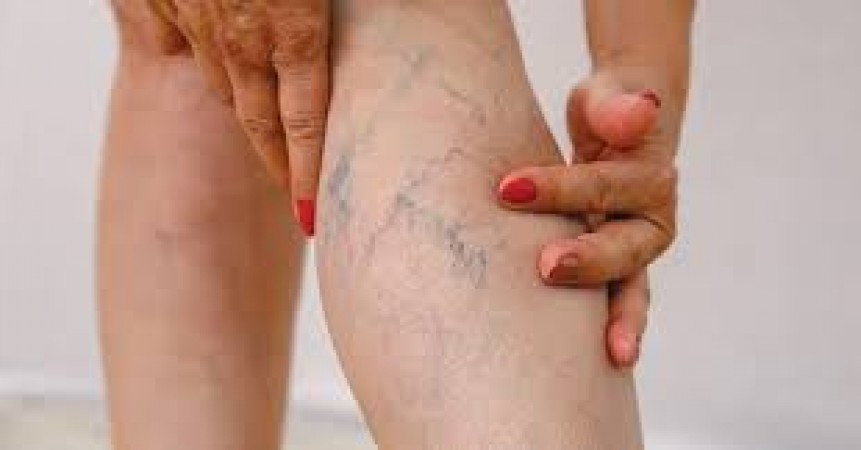
Blue veins, also known as varicose veins or spider veins, are enlarged and swollen veins that appear blue or purple in color. They typically develop on the legs but can occur on other parts of the body as well. These veins may appear twisted, bulging, or raised above the skin's surface, giving them a prominent and often unsightly appearance.
Causes of Blue Veins on Legs
1. Weak or Damaged Vein Valves The veins in our legs have one-way valves that help regulate blood flow back to the heart. When these valves weaken or become damaged, they may fail to close properly, allowing blood to flow backward and pool in the veins. This pooling of blood leads to increased pressure within the veins, causing them to enlarge and become visible as varicose veins.
2. Genetics Genetics play a significant role in the development of varicose veins. If you have a family history of varicose veins, you are more likely to develop them yourself. This suggests that there may be inherited factors that predispose certain individuals to weakened vein valves or other vein abnormalities.
3. Age As we age, the walls of our blood vessels, including veins, tend to lose elasticity and become less flexible. This natural aging process can weaken vein valves and contribute to the development of varicose veins. Additionally, older adults may have accumulated years of wear and tear on their veins, further increasing the likelihood of venous insufficiency.
4. Pregnancy Pregnancy is a common risk factor for the development of varicose veins in women. During pregnancy, the body undergoes hormonal changes that can weaken vein walls and valves, making them more prone to enlargement. Additionally, the growing uterus puts pressure on the veins in the pelvis and lower body, further impeding blood flow and increasing the risk of varicose vein formation.
5. Prolonged Standing or Sitting Jobs or activities that require prolonged periods of standing or sitting can increase the risk of developing varicose veins. When we stand for long periods, gravity makes it harder for blood to flow upward from the legs to the heart, leading to pooling of blood in the veins. Similarly, sitting for extended periods can compress the veins in the legs, further hindering blood circulation and promoting varicose vein formation.
6. Obesity Being overweight or obese is a significant risk factor for varicose veins. Excess weight puts added pressure on the veins, particularly those in the lower body, increasing the likelihood of venous insufficiency and varicose vein development. Additionally, obesity is often associated with a sedentary lifestyle, which can exacerbate poor circulation and contribute to vein problems.
Symptoms of Blue Veins on Legs In addition to the characteristic appearance of enlarged, blue or purple veins on the legs, individuals with varicose veins may experience a range of symptoms, including:
Treatment Options
1. Compression Stockings Compression stockings are a non-invasive treatment option for varicose veins that can help improve circulation and alleviate symptoms. These specially designed stockings apply graduated pressure to the legs, helping to promote blood flow back to the heart and prevent pooling of blood in the veins. By providing external support to the veins, compression stockings can reduce swelling, alleviate discomfort, and prevent the progression of varicose veins.
2. Lifestyle Changes Making certain lifestyle modifications can help manage varicose veins and reduce symptoms. These may include:
3. Sclerotherapy Sclerotherapy is a minimally invasive procedure used to treat small to medium-sized varicose veins and spider veins. During sclerotherapy, a sclerosing agent is injected directly into the affected veins, causing them to collapse and eventually fade from view. Over time, the body absorbs the treated veins, and blood is rerouted through healthier veins. Sclerotherapy is typically performed in a doctor's office and does not require anesthesia or downtime.
4. Laser Therapy Laser therapy, also known as endovenous laser ablation (EVLA), is a minimally invasive procedure used to treat larger varicose veins. During this procedure, a thin laser fiber is inserted into the affected vein through a small incision. The laser emits heat energy, which damages the vein walls, causing the vein to close off and eventually disappear. Laser therapy is performed under local anesthesia and usually takes less than an hour to complete. It offers excellent results with minimal discomfort and downtime.
5. Vein Stripping In cases of severe or recurrent varicose veins, surgical procedures such as vein stripping may be recommended. During vein stripping, the affected vein is surgically removed from the body through small incisions. This procedure is usually performed under general anesthesia in a hospital or surgical center. While vein stripping is effective in removing varicose veins, it is considered a more invasive treatment option and may require a longer recovery period compared to less invasive alternatives.
Prevention While certain risk factors for varicose veins, such as genetics and age, cannot be changed, there are steps individuals can take to reduce their risk and prevent the worsening of existing varicose veins:
Conclusion Blue veins on the legs, also known as varicose veins or spider veins, can be a source of discomfort and self-consciousness for many individuals. However, with proper understanding and management, it is possible to alleviate symptoms and improve the appearance of varicose veins. By incorporating lifestyle changes, wearing compression stockings, and exploring treatment options such as sclerotherapy or laser therapy, individuals can take control of their vein health and enjoy healthier, more comfortable legs.
Unlocking the Power of Pistachios: 5 Reasons to Enjoy 5 a Day
PM Modi Set to Launch AIIMS Rewari and Gurugram Metro Project
Roasted or Soaked Chickpeas: Which is More Beneficial for Health? Expert Opinions